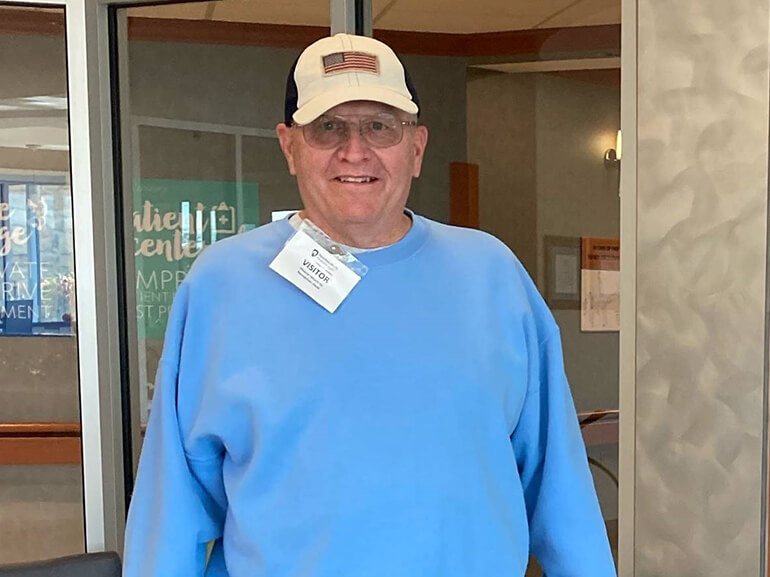Wayne's story

“Home before triple digits” became Wayne Bomberger’s goal. At the age of 70, Wayne was an active man and enjoyed fishing, kayaking and painting scenery and animals he saw along the way. He also enjoyed writing short stories and biking in Gettysburg with his devoted wife, Peggy.
Wayne and Peggy began not feeling well and got tested for COVID-19 at their local pharmacy. Over the next 10 days, Wayne’s symptoms worsened so he went to Holy Spirit Hospital to get checked out. He was admitted immediately as his breathing became more difficult and required BiPAP, non-invasive ventilation that delivers pressurized air via a mask, to compensate for his respiratory failure.
For 33 days, Peggy and her family sat outside the hospital on a hillside and waited for signs of hope as Wayne’s nurses would communicate via signs from an upper floor window. A nurse recalled seeing Peggy in her spot during a thunderstorm waiting for her update. Unfortunately, Wayne’s breathing further declined requiring intubation and ultimately ventilator support for nearly six weeks. He also endured multiple complications including a skin infection, which caused open wounds to form all over his back from the medications that were helping to keep the virus at-bay. Additionally, he suffered a brain bleed, a bowel obstruction and kidney failure.
At one point, Wayne’s family was asked to consider making end-of-life decisions, given his grim prognosis. However, as everyone came to find out, Wayne was a fighter and giving up was not an option for him or Peggy. Their mutual stubbornness paid off. Wayne was liberated from the ventilator and given a tracheostomy and feeding tube. After another 13 days of being stabilized, Wayne was cleared to transfer to Penn State Health Rehabilitation Hospital to begin his next stage of his recovery.
In physical therapy, Wayne initially required two people to get in and out of bed, transfer into a wheelchair with use of a transfer board and stand for upwards of 45 seconds in parallel bars. Even speaking or sitting up required more energy than he could believe. Bound by determination to walk out of the rehabilitation hospital at discharge, and the endless support from Peggy, Wayne was able to progress to levels he did not think possible.
Initially, Wayne’s therapy sessions focused on standing tolerance in the parallel bars as he was still battling low blood pressure, weakness and shortness of breath. Eventually, standing turned into walking in the parallel bars. As strength, endurance and confidence grew, Wayne was able to advance these skills outside of the parallel bars using a rolling walker. Day by day, Wayne required less assistance from therapists and was able to begin practicing these skills with Peggy by his side.
His time with occupational therapy taught Wayne how to transition in and out of bed and worked on increasing his tolerance for sitting upright in a chair for longer durations of time. Due to the severity of his leg weakness, Wayne needed a transfer board to transition to other surfaces and the assistance of two therapists. As Wayne’s endurance increased, he progressed to completing transfers with a single assist. Then came Wayne’s big turning point. His first full shower in months. This rejuvenated him and progress continued.
Peggy was there every step of the way to assist with equipment management, self-care and endless encouragement. Her enthusiasm for learning was Wayne’s motivation to keep going even when he was tired. Peggy also credits her daughter, Tracy and son-in-law, Ken with providing much needed support. “I couldn’t have gotten through this journey without them,” said Peggy. “They provided emotional support, helped make medical decisions and also took care of everything at home so I could be by Wayne’s side."
As Wayne approached his discharge date, he was happy to achieve his “home before triple digits” goal. Exactly 99 days after walking into Holy Spirit, Peggy finally got to take Wayne home. He was even happier that he achieved his other big goal – to walk independently out of the hospital, which he did.
Wayne expressed his gratitude for the care he received at Penn State Health Rehabilitation Hospital, calling his care team members “hardworking people.” He recalled seeing other patients during their recovery and the motivation that provided him, in addition to the cheers and well wishes from friends, family and staff members. Wayne’s most important takeaway from this whole experience: “Family is the most important thing.”
Wayne looked forward to returning to a more independent life with continued therapies at the Penn State Health Rehabilitation Hospital outpatient center.
Wayne recently returned to the hospital for a visit and informed his therapists that he was cane-free for more than six weeks. He proudly shared that he’s back to riding his bike up to 3.4 miles once a week and playing “slow ball” tennis twice a week. Wayne is also painting the landscape view from the back of the rehabilitation hospital, which includes a farmer’s field with cows. He plans to gift it to the hospital when it’s completed.